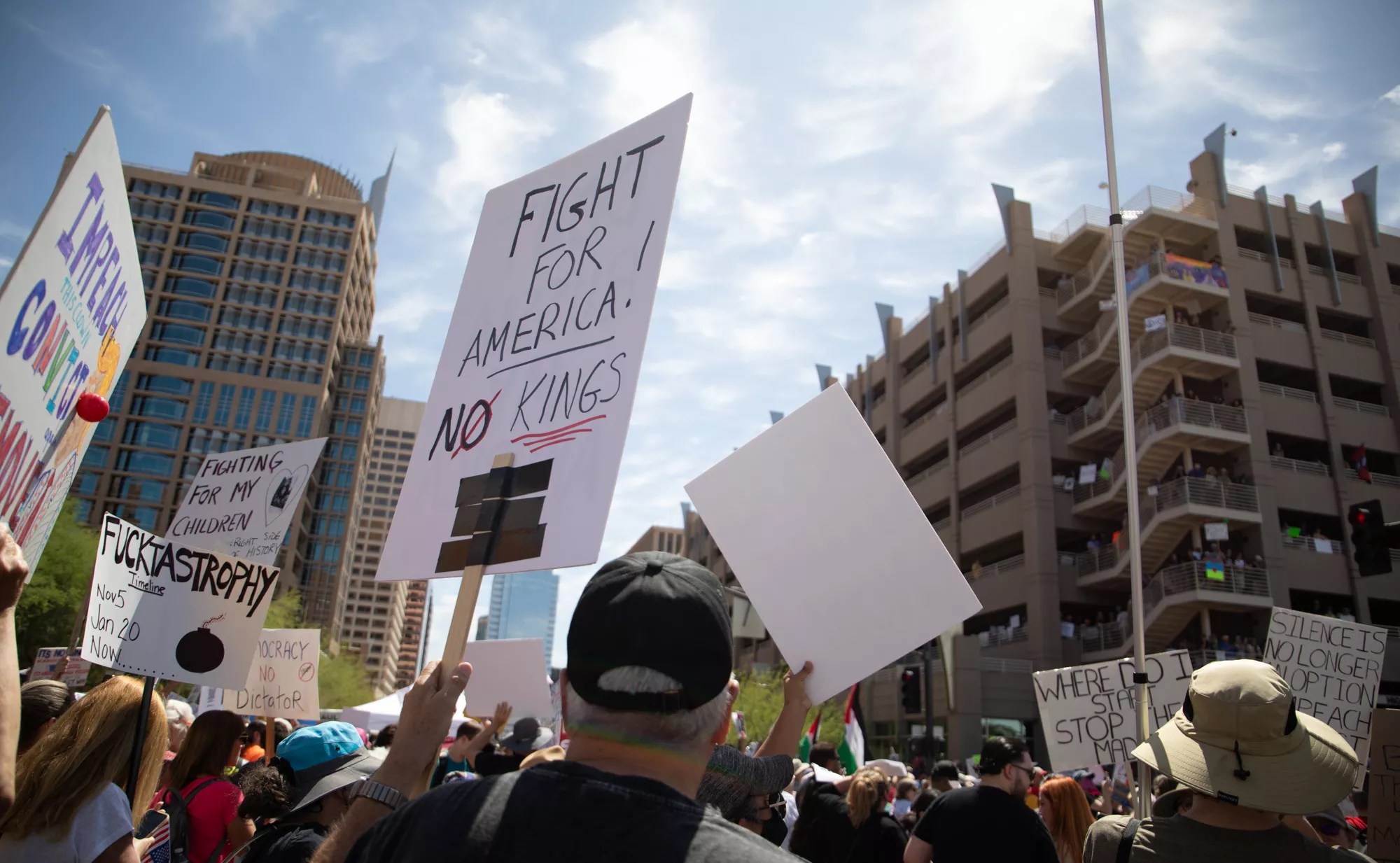
Grace Monos

Audio By Carbonatix
The first 100 days of Donald Trump’s second presidency have been a hellscape.
He’s empowered Elon Musk to slash federal programs and agencies, capriciously laying off workers and pulling the plug on crucial funding initiatives. He’s terrorized immigrant communities, deporting people on flimsy pretext and with little regard for due process. Economically, he’s imposed and rescinded onerous tariffs willy-nilly, tanking the economy and retirement savings in the process.
It’s left many Americans scared and angry, and they haven’t been shy about saying so. In Arizona and across the country, large-scale grassroots protests have popped off at a regular pace, giving people an outlet to vent their rage.
In Arizona, protesters have rallied outside the Arizona Capitol, at Tesla dealerships and in front of Phoenix Children’s Hospital. Thursday, more than 1,500 people demonstrated at a “May Day” protest – a day historically used to push for worker rights – in front of the Capitol before marching to the Sandra Day O’Connor U.S. Courthouse downtown. Clearly, protest organizers know how to drum up attendance.
However, as the nation enters its fifth month under the second Trump administration, a question lingers. People will come out and protest. But what comes next?
That question was on the minds of local organizers at Thursday’s protest. More than 25 organizations, many of which helped organize the “May Day” protest, are forming a coalition to funnel protestors into other avenues of activism. OK, you’ve carried a sign and chanted at the Capitol. Why not join an organization to get more involved?
“We’ve created an infrastructure for people to plug in with the organizations that already exist,” said former state Sen. Raquel Terán, who organized Thursday’s demonstration and is a veteran of grassroots organizing. “We’re inviting them to plug in wherever they see fit and create their own organization.”
Anyone who attended Thursday’s protest probably encountered a banner or a flyer with a number to text. That number connected them to a webpage listing a variety of organizations itching to activate them. They could join groups like Organized Power in Numbers, which fights for housing justice; Living United for Change in Arizona, which focuses on immigration rights; or Save Our Schools, which fights for public education.
And so much more. Trump has opened battlefronts on all of their doorsteps.
Not that protesting isn’t a valuable action on its own. They’re big, they’re loud and they get headlines. “I don’t see how they’re not paying attention and not getting a little bit scared,” activist Jeremy Helfgot said of the Trump administration. “This is growing larger than they can control. The crowd is continuing to be empowered and it’s going to continue to get louder and stronger. It’s not going away.”
But if speech doesn’t turn into action, the effect becomes ephemeral. By turning protesters into active members of community organizations, local activists hope to turn their willingness to make noise into more concerted efforts to enact real change.

Former state Sen. Raquel Terán was one of the main organizers of Thursday’s “May Day” protest.
Grace Monos
“There’s no magic pill,” said Beatriz Topete, a union organizer with Phoenix-based labor union UNITE HERE Local 11. “We have to continue building that groundwork. We’re only as strong as the number of members and people who understand and join together.”
That will take work, organizers said – specifically work that grassroots organizations are positioned to do. They just need the manpower.
They need people to knock on doors and write letters. They need folks who are willing to attend their local city council or school board meeting and to sign up to speak in front of lawmakers at the Arizona Legislature. They need people to host community information sessions, demystifying for their neighbors the intricacies of the budget process, tax law and how to lobby public officials.
Many groups that spearheaded Thursday’s protest already have pelts on their walls. More than a decade ago, Terán organized against Arizona’s infamous Senate Bill 1070, which led to the successful recall of far-right Sen. Russell Pearce, who sponsored the bill. Unions like UNITE HERE Local 11 have supported the strikes of hundreds of unions across the state. In 2018, the Arizona Education Association helped raise teacher pay by 20% through the Red for Ed movement.
This moment is bigger than all of those, but that experience is something to lean on.
“We come from a history of fighting back. We need to look back at every single movement and how they fought back,” Terán said. “We have to try every single tactic and more. At the end of the day, take it to the next level. We’re only limited by our imagination.”
That fight will take commitment. It’s easy – maybe even fun – to pop into a protest every now and then. The real work of change is much more anonymous and much more thankless. Not every person who chants anti-Trump slogans at a rally will have the will or the time to get more involved. Those who do sign up need to know what they’re getting into.
“We have to keep people understanding how patient we have to be,” said Arizona Education Association President Marisol Garcia. “This democracy took a long time to build. So this is going to take some time.”
But while that more impactful work begins to take shape, the protest figure to continue. Trump isn’t slowing down. Organizers are determined to match his velocity.
“We’re showing that power rests with the people and sooner or later, the crowd gets too big and can’t be ignored,” said Helfgot. “And that day is going to come.”